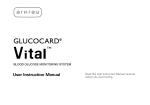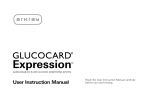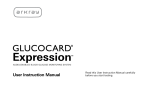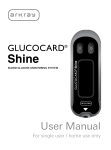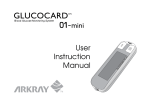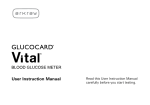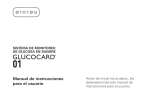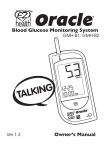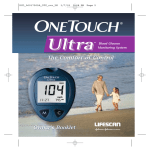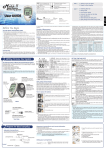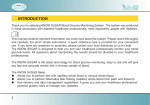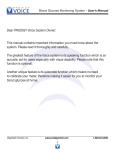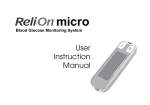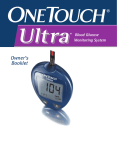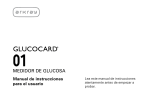Download GLUCOCARD 01 User Manual
Transcript
BLOOD GLUCOSE MONITORING SYSTEM User Instruction Manual Read this User Instruction Manual carefully before you start testing. CAUTION: Before using any product to test your blood sugar (blood glucose), read all instructions and practice the test. Do all quality control checks as directed and consult with a diabetes healthcare professional. TABLE OF CONTENTS Introduction . . . . . . . . . . . . . . . . . . . . . . . . . . . . . . . . . . . . . . . . . . . 5 Intended Use . . . . . . . . . . . . . . . . . . . . . . . . . . . . . . . . . . . . . . . . 6 Important Safety Instructions . . . . . . . . . . . . . . . . . . . . . . . . . . . 6 Warnings, Precautions & Limitations. . . . . . . . . . . . . . . . . . . . . . 8 Understanding the GLUCOCARD 01 Blood Glucose Meter . . . . . . 11 Changing the Battery. . . . . . . . . . . . . . . . . . . . . . . . . . . . . . . . . 14. Meter Set-up. . . . . . . . . . . . . . . . . . . . . . . . . . . . . . . . . . . . . . . . . . 17 Basic Rules. . . . . . . . . . . . . . . . . . . . . . . . . . . . . . . . . . . . . . . . . 17 Audible Beep . . . . . . . . . . . . . . . . . . . . . . . . . . . . . . . . . . . . . . . 20 Year. . . . . . . . . . . . . . . . . . . . . . . . . . . . . . . . . . . . . . . . . . . . . . 22 Month/Day. . . . . . . . . . . . . . . . . . . . . . . . . . . . . . . . . . . . . . . . . 23. Hour/Minute . . . . . . . . . . . . . . . . . . . . . . . . . . . . . . . . . . . . . . . 24. Test Averaging . . . . . . . . . . . . . . . . . . . . . . . . . . . . . . . . . . . . . . 25. Ending Set-up. . . . . . . . . . . . . . . . . . . . . . . . . . . . . . . . . . . . . . 26 Performing a Control Solution Test . . . . . . . . . . . . . . . . . . . . . . . . . 27 Troubleshooting Control Solution Test . . . . . . . . . . . . . . . . . . . . 34 3 Blood Glucose Testing . . . . . . . . . . . . . . . . . . . . . . . . . . . . . . . . . . . . . . . . Obtaining a Drop of Blood . . . . . . . . . . . . . . . . . . . . . . . . . . . . . . . . . . . Performing a Blood Glucose Test . . . . . . . . . . . . . . . . . . . . . . . . . . . . . . Flagging Test Results. . . . . . . . . . . . . . . . . . . . . . . . . . . . . . . . . . . . . . . Cleaning & Disinfecting Meter & Lancing Device . . . . . . . . . . . . . . . . . . . . Alternate Site Testing (AST) . . . . . . . . . . . . . . . . . . . . . . . . . . . . . . . . . . . . Downloading Test Results to a Computer . . . . . . . . . . . . . . . . . . . . . . . . . . Understanding Test Results . . . . . . . . . . . . . . . . . . . . . . . . . . . . . . . . . . . . Recalling Results - Entering Memory Mode. . . . . . . . . . . . . . . . . . . . . . . . Maintenance . . . . . . . . . . . . . . . . . . . . . . . . . . . . . . . . . . . . . . . . . . . . . . . . Display Screen and Error Messages . . . . . . . . . . . . . . . . . . . . . . . . . . . Storage and Handling. . . . . . . . . . . . . . . . . . . . . . . . . . . . . . . . . . . . . . . Product Information. . . . . . . . . . . . . . . . . . . . . . . . . . . . . . . . . . . . . . . . . . . Product Specifications . . . . . . . . . . . . . . . . . . . . . . . . . . . . . . . . . . . . . . Warranty . . . . . . . . . . . . . . . . . . . . . . . . . . . . . . . . . . . . . . . . . . . . . . . . 4 37 37 40 44 46 52 60 61 67 71 71 76 78 78. 79 INTRODUCTION Thank you for choosing the GLUCOCARD 01 Blood Glucose Monitoring System. This system measures blood glucose in fresh capillary whole blood. Results are shown as plasma values. This makes it easy to compare the GLUCOCARD 01 blood glucose meter and lab results. Please read this manual before using the system. If you have any questions, call ARKRAY Customer Service at 800.566.8558 (24 hours a day, 7 days a week, USA and Canada only). Contact your healthcare professional with questions if you are unable to reach Customer Service. 5 Intended Use The GLUCOCARD 01 Blood Glucose Monitoring System is intended for the quantitative measurement of glucose in fresh capillary whole blood samples drawn from the fingertips or palm. Testing is done outside the body (In Vitro diagnostic use). It is indicated for use at home by persons with diabetes as an aid to monitor the effectiveness of diabetes control. It is not intended for the diagnosis of or screening for Diabetes Mellitus, and is not intended for use on neonates. It is intended for single patient use and should not be shared with other individuals. Important Safety Instructions WARNING: • The meter and lancing device are for single patient use. Do not share them with anyone including other family members! Do not use on multiple patients! • All parts of the kit are considered biohazardous and can potentially transmit infectious diseases, even after you have performed cleaning and disinfection.¹,² 6 Cleaning & Disinfecting Meter & Lancing Device All parts of the blood glucose meter and lancing device are considered biohazardous and can potentially transmit infectious diseases. CLEANING removes dirt and other visible material whereas DISINFECTING destroys organisms that can cause infection or disease such as Hepatitis B, C, and HIV. For complete cleaning and disinfecting instructions see page 48 of this manual. ¹ “ FDA Public Health Notification: Use of Fingerstick Devices on More than One Person Poses Risk for Transmitting Bloodborne Pathogens: Initial Communication” (2010) http://www.fda.gov/MedicalDevices/ Safety/AlertsandNotices/ucm224025.htm ² “CDC Clinical Reminder: Use of Fingerstick Devices on More than One Person Poses Risk for Transmitting Bloodborne Pathogens” (2010) http://www.cdc.gov/injectionsafety/Fingerstick-DevicesBGM.html 7 Warnings, Precautions & Limitations • Never make significant changes to your diabetes control program or ignore physical symptoms without consulting with your healthcare professional. • Patients undergoing oxygen therapy may yield false results. • Severe dehydration (excessive water loss) may cause false low results. If you believe you are suffering from dehydration, consult your healthcare professional right away. • Extremes in hematocrit may affect test results. Hematocrit levels less than 30% may cause falsely high readings. Hematocrit levels greater than 55% may cause falsely low readings. • Inaccurate results may occur in severely hypotensive individuals or patients in shock. Inaccurate low results may occur for individuals experiencing a hyperglycemic-hyperosmolar state, with or without ketosis. This meter should not be used to test critically ill patients. • Triglycerides up to 3,000 mg/dL do not significantly affect test results. However, glucose values in specimens beyond this triglycerides level should be interpreted with caution. 8 • Normal endogenous (within body) natural levels of uric acid, ascorbate (vitamin C), bilirubin, triglycerides, and hemoglobin do not interfere with your blood glucose results obtained. • Externally taken drugs L-dopa, dopamine, methyl-dopa, acetaminophen, and ibuprofen will not interfere with GLUCOCARD 01 blood glucose results when taken at therapeutic concentrations. • The GLUCOCARD 01 Blood Glucose Monitoring System should not be used for the diagnosis of diabetes. • Use only fresh capillary blood. • Do not use the GLUCOCARD 01 Blood Glucose Monitoring System to test neonates. It has not been validated for neonatal use. • Always insert the test strip into the meter first, then lance the finger. Not doing so may result in an“E-6” appearing on the display or a test result that is higher than the actual value. • Do not use at altitudes higher than 10,000 ft (3,048 m). 9 The System Includes: • Meter • Carrying Case • User Instruction Manual • Quick Reference Guide • Self-testing Logbook • Test Strips* • Control Solution* • Lancing Device and/or Lancets* *Required, but may be sold separately Control Solution 10 Carrying Case UNDERSTANDING THE GLUCOCARD 01 BLOOD GLUCOSE METER Top Bottom Battery Compartment Cover Tab Display Test Strip Port Orange/Up Arrow Data Connection Terminal Gray/Down Arrow 11 Explanation of the full display screen: Memory Mode Symbol Battery Symbol Audible Beep Off Apply Blood Symbol Unit of Measurement Date Time Format Temperature Warning Delete Symbol Control Solution NOTE: The correct unit of measurement in the U.S. is mg/dL. If your meter is not set to mg/dL at the time of purchase, contact ARKRAY Customer Service at 800.566.8558. 12 GLUCOCARD® 01 SENSOR PLUS TEST STRIPS These test strips need only 0.3 µL (microliter) of blood. Apply blood to the sample application tip. The strip draws in the blood by capillary action. The blood glucose reacts with the enzyme on the test strip. This produces a current proportional to the blood glucose level. The meter detects the current and converts it into a blood glucose reading. Test Strip Bottle Test Strip Code No. (F-2, 3 or 4) Contact Bars Insert this way into meter Front Back Sample Application Tip (Apply blood to end of test strip. Capillary draw will pull blood to reaction site). 13 Changing the Battery The GLUCOCARD 01 blood glucose meter comes with one lithium battery CR2032 (or DL2032). CAUTION: Replacing the battery will not delete meter settings or test results stored in the meter unless you: • Take over 5 minutes to replace battery. • Load the battery incorrectly. • Load a used or weak battery. NOTE: • To save battery power, the meter turns itself off 3 – 5 minutes after last use. • Replace batteries when low battery symbol appears. Otherwise inaccurate results could be obtained. •Discard used batteries as per local guidelines. WARNING: Keep all batteries out of children’s reach. If a battery is swallowed, consult a doctor immediately. 14 To replace battery: 1. Open the battery cover on the back side of the meter by pushing the tab in the direction of the arrow and pulling the cover up. 2. The battery is held in place on the underside of the cover. Slide the battery out of the cover. 3. Load a new battery into the battery cover. Place the “+” side down when loading the battery into the cover. 4. Make sure the battery is loaded in the proper position. Otherwise, the preprogrammed times will be reset. 15 5. Put the battery cover back into correct position and snap to close. If the clock setting has been deleted, either “12:00” or “0:00” will blink when you put a test strip into the meter. The low battery symbol means you need to replace the battery as soon as possible. Discard used batteries as per local guidelines. 16 METER SET-UP Before using the GLUCOCARD 01 blood glucose meter for the first time, set the time and date. Do not perform a blood glucose test until you have setup the meter. Meter set-up allows you to adjust the audible beep volume and to set time, date, and test averaging. Basic rules for meter set-up: Step 1: Enter meter set-up by first making sure the meter is turned off. Orange/Up Arrow Gray/Down Arrow 17 Step 2: Press the Orange/Up Arrow and Gray/ Down Arrow buttons at the same time for 5 seconds. A beep sounds and the meter turns on. Next, a second beep sounds and “SET” shows on the screen. Step 3: Use the Orange/Up Arrow to change the set-up screen. When you press the Orange/Up Arrow, the set-up screen changes in the order shown in the diagram to the right. Press the Gray/Down Arrow button to change a setting within a set-up screen menu. NOTE: If you need to go back to a setting, you must scroll through each set-up option. You cannot go backwards in set-up mode. In set-up mode, the meter will turn off automatically after 3 minutes of non-use. 18 Setting the 1 Audible Beep Orange Arrow Orange Arrow Orange Arrow Orange Arrow Setting Setting 7 Test Set-up <Power OFF> the Day Month Return 8 Ending Orange Arrow 4 Setting 3 the the Year Orange Arrow Gray Arrow Setting 2 Setting 6 the Averaging Orange Arrow Minute Setting 5 the Hour Orange Arrow Orange Arrow 19 Setting the Audible Beep If the audible beep is turned “on”, the beep will sound when: • You insert a test strip into the meter. • You apply blood or control solution to a test strip. • The test has ended and the result is displayed. • The meter is turned on, but you do not use it for several minutes. Meter will beep and automatically shut off. • You go into Memory Mode. Make sure the meter is off. Press the Orange/Up Arrow and Gray/Down Arrow buttons at the same time for 5 seconds. A beep sounds and the meter ep turns on. Next, a second beep sounds and “SET” Be shows on the screen. Press the Orange/Up Arrow button. The screen will display “bUZ” and the current beep setting. 20 Press the Gray/Down Arrow button to cycle through the volume levels: “OFF” (no sound) ”on 1” (low) [1] “on 2”(middle) “on 3” (high) “OFF” (no sound) …, etc. A beep sounds at the set volume at each step. If “OFF” is set, the “audible beep mute (Off)” symbol lights up in the upper right of the screen. After you select the beep volume, press the Orange/Up Arrow button to confirm the setting. The screen changes to the year set-up screen. [1] Be ep Be [1] ep ep Be [1] 21 Setting the Year In the year set-up screen, the last two digits of the currently set year appear at the top of the screen. “yER” appears in the middle of the screen. All four digits of the currently set year appear at the bottom of the screen. The last two digits will blink. Press the Gray/Down Arrow to change the last two digits of the year to the correct year. After you set the year, press the Orange/Up Arrow button to confirm the setting. The screen changes to the month set-up screen. [1] [2] [3] 22 Setting the Month Press the Gray/Down Arrow button to change the month. After you set the month, press the Orange/Up Arrow button to confirm the setting. The screen changes to the day set-up screen. Setting the Day Press the Gray/Down Arrow button to change the day. After you set the day, press the Orange/Up Arrow button to confirm the setting. The screen changes to the hour set-up screen. [1] [2] [3] [4] 23 Setting the Hour Press the Gray/Down Arrow button to change the hour. After you set the hour, press the Orange/Up Arrow button to confirm the setting. The screen changes to the minute set-up screen. [1] Setting the Minute Press the Gray/Down Arrow button to change the minute. After you set the minute, press the Orange/ Up Arrow button to confirm the setting. The screen changes to the test averaging set-up screen. [2] [3] [4] 24 Setting Test Averaging NOTE: “Lo” results are included as 20 mg/dL in the averages. “Hi” results are included as 600 mg/dL in the averages. Press the Gray/Down Arrow button to cycle through the test averaging choices: “oFF” (not displayed), “14” (14-day average), or “30” (30-day average).“AVE” appears near the middle of the screen. If you select either 14-day or 30-day averaging, your average test result will appear when you recall results from memory. See page 69. After you set test averaging, press the Orange/Up Arrow button to confirm the setting. The display changes to the data download baud rate set-up screen. 25 Ending Set-up To make further changes to set-up settings, press the Gray/Down Arrow button while “End” is displayed. This will bring up the Audible Beep set-up screen. You can then move through the set-up mode and adjust any settings that you wish. If you are done with set-up, press the Orange/Up Arrow button while “End” is displayed. This confirms all settings and turns the meter off. ep Be <Power OFF> The meter will turn off automatically 3 minutes after “End” is displayed. 26 PERFORM A CONTROL SOLUTION TEST It is recommended to use GLUCOCARD® 01 CONTROL to check if: • the meter and test strips are working correctly as a system. • you are testing correctly. Call your local supplier or pharmacy to order control solution. If they do not stock it, call ARKRAY Order Services at 800.566.8558 (USA and Canada only). 27 It is recommended to perform a Control Solution Test: • • • • • • When you open a new bottle of test strips. Whenever you suspect the meter or test strips may not be functioning properly. If test results appear to be abnormally high or low or are not consistent with clinical symptoms. The test strip bottle has been left open or has been exposed to temperatures below 34°F (1°C) or above 86°F (30°C), or humidity levels outside the range of 20%-80% relative humidity. To check your technique. When the GLUCOCARD 01 blood glucose meter has been dropped or stored below 32°F (0°C) or above 122°F (50°C). IMPORTANT: • Use only with GLUCOCARD 01 blood glucose meter and GLUCOCARD 01 SENSOR PLUS blood glucose test strips. 28 • GLUCOCARD 01 CONTROL is not intended for human consumption. Do not drink. • Do not apply to eye. Contact your healthcare professional immediately if solution is swallowed, injected, or applied to the eye. • Dye in control solution may stain skin, clothing, or surfaces. • Store the control solution between 34-86°F (1-30°C). Keep away from direct sunlight, fluorescent light, and heat. Do not freeze. • Use before the expiration date printed on bottle. • Use the control solution within 3 months of first opening. It is recommended that you write the date of opening on the control solution bottle label (OPEN DATE) as a reminder to dispose of the opened solution after 3 months. • Always replace the cap immediately after use. • GLUCOCARD 01 CONTROL is not a cleaning solution. Do not clean your GLUCOCARD 01 blood glucose meter with GLUCOCARD 01 CONTROL. • Use the Control Solution between 72-82°F (22-28°C). 29 Step 1: Insert a test strip as shown in diagram. Test strip should seat firmly into meter. The meter will turn on automatically. The full screen will come on for a moment. Make sure all symbols appear on the screen (see page 12). Then the code number (F-2, F-3, or F-4) will appear and will alternate with the Apply Blood symbol. Make sure that the code number on the screen matches the code number on the test strip bottle. If screen code does not match the test strip code, use a new test strip. If code still does not match, use a new bottle of test strips or call Customer Service at 800.566.8558 (24 hours a day, 7 days a week, USA and Canada only). 30 Step 2: Press the Orange/Up Arrow button to enter the control mode. You will see “CONT” on the bottom right of the screen. If you do not enter the control solution mode, the control solution result will NOT be valid. Orange/Up Arrow Gray/Down Arrow 31 Step 3: Mix control solution by gently inverting bottle. Remove the cap from the control solution bottle. While the Apply Blood symbol and Code No. (F-2, F-3 or F-4) are alternating, place a drop of the control solution on the end of the test strip. DO NOT put control solution on top of the test strip. The test strip will draw up the solution and the meter will beep. The meter will begin to count down. Step 4: In 7 seconds the meter will beep again and display the control solution result. Compare the result to the range printed on the test strip bottle. Make sure the result is within the acceptable range. If the result falls within this range, the meter and test strip are working correctly. 32 Do not use the system if control solution result is out of range. See Troubleshooting Control Solution Test (page 34). Result is automatically stored in memory. See page 69 for additional information Step 5: Remove test strip. Dispose of the used test strip. Control solutions are available in three (3) levels - L1, L2, and L3. Repeat Steps 1-5 with other Control Solution levels as per recommendations of your healthcare professional. Call your local supplier or pharmacy to order control solution. If they do not stock it, call ARKRAY Order Services at 800.566.8558 (USA and Canada only) NOTE: Control solution test results are not included in the averages. 33 Troubleshooting Control Solution Test If the control solution test result is out-of-range, check the following and repeat the test: Check Action Did you do the test in control solution mode? Do you see “CONT” on the screen with the result? If not, do the test again. Insert a test strip; press the Orange/Up Arrow button for control solution mode. “CONT” should appear on screen. Make sure that test strips and control solutions are not past expiration date. Have the test strips and/or This date is shown on bottle. Make control solution expired? sure bottles have not been opened for more than three months. Were control solutions at room If not, retest with new bottle temperature (72-82°F (22-28°C)) of control solution, or warm up/cool when used? down to room temperature. Does the code on the test strip bottle If not, obtain a new bottle match the code on the meter screen? of test strips. 34 Check Did you insert test strip firmly into meter? Did you follow the procedure correctly? Action Make sure test strip is inserted all the way into test strip port. See diagram on page 30. Reread “Performing a Control Solution Test” (pages 27-33) and retest. Were test strips stored correctly (between 34-86°F (1-30°C))? If not, retest with a Was the bottle cap replaced new bottle of test strips. immediately after removing a test strip? Is the meter damaged? If yes, contact ARKRAY Customer Service at Does it show an error code? 800.566.8558. 35 Does your Control Solution result still read outside the range printed on the test strip bottle? If yes, the system may not be working correctly. DO NOT USE the system to test your blood glucose until the control solution result is within range. If you need help, please call ARKRAY Customer Service at 800.566.8558 (24 hours a day, 7 days a week, USA and Canada). Contact your diabetes healthcare professional if you cannot reach Customer Service. 36 BLOOD GLUCOSE TESTING Obtaining a Drop of Blood Step 1: Wash hands with soap and warm water. Dry hands thoroughly. If you use alcohol wipes to cleanse fingers, make sure the area is dry before lancing finger. Residual alcohol may lead to inaccurate readings. Step 2: Let the arm hang down for 10 to 15 seconds. (Holding the arm below the heart and massaging the wrist, palm and finger makes it easier to obtain a blood drop). Step 3: Choose a site on the side of a fingertip to minimize pain. 37 Step 4: Press the lancing device to the side of the fingertip. Press the lancing device button. Follow manufacturer’s instruction for how the lancing device or lancet should be used. Step 5: Set aside the lancing device and wait a few seconds for a blood drop to form. Keeping the hand warm, lowering the hand to waist level and gently massaging your wrist, palm or the base of the finger helps the flow of blood. Use a different site each time you test to help prevent soreness and calluses. DO NOT share used lancets with another person. To prevent possible infection, a used lancet should not be touched by another person. A lancet should only be used once. After use, put the protective cap back on and dispose of lancet in a safe manner to avoid accidental stick injuries. 38 NOTE: Do not use the lancet if the cap is missing or damaged. WARNING: Lancing devices, lancets and meters are for single-patient use only and should never be shared with another person, even a family member. This lancing device should not be used for multi-patient testing by healthcare providers or at healthcare provider sites. All parts of the kit are considered biohazardous and can potentially transmit infectious diseases, even after you have performed cleaning and disinfection. 39 Performing a Blood Glucose Test NOTE: Four and a half minutes after test strip insertion, a beep sounds every 5 seconds. After 5 minutes, a beep sounds and the meter turns off. Take out unused test strip and insert it again to turn meter back on. Step 1: Remove test strip from the bottle. Immediately replace the bottle cap tightly. Insert test strip as shown in diagram. A beep will sound and the meter will turn on automatically. Verify that all symbols appear on the screen. 40 Step 2: The beep will sound again. The Apply Blood symbol and the code number (F-2, F-3, or F-4) will alternate on the screen. Verify that the code number on the screen matches the code number printed on the bottle. If the code number does not match, the meter may give a false reading. If code does not match, use a new strip. If code still does not match, use a new bottle of test strips or call Customer Service at 800.566.8558 (24 hours a day, 7 days a week, USA and Canada only). Verify that the date and time appear on the screen and are correct. If date and time are not correct, reset them (see Meter Set-up, page 17). 41 Step 3: Obtain a blood drop (see pages 37-39). Apply blood to the end of the test strip. Capillary action will pull the blood into the strip. The meter will beep when it detects that blood has been applied. The meter will begin to count down. Do not add blood on top of the test strip, as you may receive an inaccurate result. IMPORTANT: Ensure that enough blood is applied to fill the check window and it turns red. When the check window is filled with blood and a beep sounds, remove the tip of the test strip from your finger. If there is not enough blood, “E-7” or “Lo” will be displayed. Filled 42 Filled Not Filled Not If it takes longer than 20 seconds to obtain a blood sample and to touch the test strip to the blood drop, repeat Step 3. Step 4: The meter will count down, starting from “7”. After 7 seconds, a beep sounds and the test result and date/time are shown. Results will be shown in units of mg/dL. Record result in your logbook. Step 5: When the test is done, pull out test strip. Dispose of used test strip carefully. The meter shuts off automatically when you remove the test strip. A lancet should be used once. After use, put protective cap back on and remove lancet from lancing device. Dispose lancet in a safe manner so as not to cause accidental injury. mg/dL 43 Flagging Test Results You can mark a test result with either “DEL” or “CONT” or leave it unmarked. You must mark the test result after it has been displayed, but before you remove the test strip from the meter. You cannot change the marker after removing the test strip from the meter. mg/dL • “DEL”: Mark a test result with “DEL” if you feel the result is incorrect or the test procedure was not followed correctly. The result will be stored in memory, but will not be used for Test Averaging. (See page 25). • “CONT”: Mark control solution test results with “CONT”. (See page 31). Step 1: Wait for test result to be displayed. Be sure test strip is still in meter. Press the Orange/Up Arrow button to cycle through the options: “DEL”—> “CONT” —> Unmarked —> “DEL”, etc. 44 Step 2: When you have selected the desired marker, remove the test strip. When you recall the result from memory, the selected marker will be displayed (“DEL”, “CONT” or no marker). mg/dL NOTE: The following are NOT included in the 14-day or 30-day test averages: • Results collected in Control Solution mode (and therefore marked“CONT”). • Results marked “CONT” or “DEL” by you. • Results obtained when date and time have not been set. [1] mg/dL [2] mg/dL NOTE: Results collected in Control Mode automatically show “CONT” when the result is first displayed and when it is reviewed in Memory. 45 CLEANING & DISINFECTING METER & LANCING DEVICE WARNING: • The meter and lancing device are for single patient use. Do not share them with anyone including other family members! Do not use on multiple patients! • All parts of the kit are considered biohazardous and can potentially transmit infectious diseases, even after you have performed cleaning and disinfection.¹,² CLEANING removes dirt and other visible material whereas DISINFECTING destroys organisms that can cause infection or disease such as Hepatitis B, C, and HIV. Your meter and lancing device should be CLEANED and DISINFECTED a minimum of once per week and immediately when blood is visible, for up to 2 cleaning and disinfection cycles per week over the 4 year use life of the device. 46 If meter is being operated by a second person who is providing testing assistance to the user, the meter and lancing device should be cleaned and disinfected prior to use by the second person. In addition, caregivers should wear gloves when testing another person’s blood. Wash hands thoroughly with soap and water after handling the meter, test strips, lancing device or disinfecting wipes. For technical assistance or questions on cleaning and disinfecting, call ARKRAY Customer Service at 800.566.8558 (24 hours a day, 7 days a week, USA and Canada only). ¹ “ FDA Public Health Notification: Use of Fingerstick Devices on More than One Person Poses Risk for Transmitting Bloodborne Pathogens: Initial Communication” (2010) http://www.fda.gov/MedicalDevices/ Safety/AlertsandNotices/ucm224025.htm ² “CDC Clinical Reminder: Use of Fingerstick Devices on More than One Person Poses Risk for Transmitting Bloodborne Pathogens” (2010) http://www.cdc.gov/injectionsafety/Fingerstick-DevicesBGM.html 47 CLEANING and DISINFECTING your meter or lancing device with germicidal disposable wipes. Use one wipe for cleaning and a second wipe for disinfecting. The following product has been validated to CLEAN and DISINFECT your meter and lancing device. Manufacturer’s Active Product Item No. Ingredients Clorox® Germicidal 30577 Sodium Wipes Hypochlorite............0.55% *Product accessibility may vary according to retail availability. 48 Where to Buy* Retail:Kmart, Sears, Office Depot, Office Max Online: www.amazon.com and www.walmart.com CLEANING Step 1: Remove wipe from container. Step 2: METER: Hold the meter in an upright position with test strip port toward the floor and wipe down all exposed surfaces of meter. • DO NOT WRAP THE METER IN A WIPE. • Do not over saturate with liquid or let drops of disinfectant flow into test strip port, buttons, lens or other meter openings. • Do not wipe inside battery compartment, inside data connection port or inside test strip port as this may damage the meter. LANCING DEVICE: Remove removable cap. Wipe down entire lancing device and removable cap. Step 3: Dry the device thoroughly with a dry cloth. 49 DISINFECTING Two wipes must be used; one wipe to clean and a second wipe to disinfect. After cleaning your meter or lancing device, repeat steps 1, 2 and 3 using a second germicidal wipe to disinfect. Allow meter and lancing device to remain visibly wet for full contact time detailed below. Contact Time Clorox® Germicidal Wipes 1 minute NOTE: Your meter and lancing device should be CLEANED and DISINFECTED a minimum of once per week and immediately when blood is visible, for up to 2 cleaning and disinfection cycles per week over the 4 year use life of the device. Over time, cleaning and disinfecting may cause meter and lancing device deterioration. ARKRAY has validated a 4 year use life by exposing the meter and lancing device to 832 wipes (416 cycles) with the disinfectant product listed on page 50 of this user manual. This supports cleaning and disinfection twice per week over the 4 year use life of the device. 50 Physical signs of deterioration include: • Cloudy or cracked meter lens. • Cracked meter case. • Debris under meter lens. • Meter display missing components. • Lancing device cap is cloudy or streaked. • Body of lancing device shows signs of cracking, swelling, streaking, softening or brittleness. Performance signs of deterioration include: • Meter buttons not working properly. • Meter doesn’t register test strip, control solution or blood sample. • Meter turns off. • Firing button on lancing device is stuck and won’t release. • Lancing device depth setting dial is frozen/stuck. • Lancing device disposal-and-set lever is frozen/stuck. • Lancing device cap can’t be removed or replaced. If you notice any signs of deterioration, as mentioned above, stop using the device and please call ARKRAY Customer Service at 800.566.8558 (24 hours a day, 7 days a week, USA and Canada only). 51 ALTERNATE SITE TESTING (AST) Important Information About AST Sites other than your fingertip may have fewer nerve endings so obtaining a blood sample from these sites may be less painful. The technique for alternate site testing is different from fingertip testing. Blood glucose results from sites other than your fingertip could be significantly different due to blood glucose levels changing rapidly after a meal, insulin, or exercise. Consult with your diabetes healthcare professional prior to testing from a site other than your fingertips. Results obtained from sites other than the fingertip may differ significantly as is the case with all blood glucose monitoring systems. Rapidly changing results are likely to occur after eating. Insulin dosing and physical activity are shown in the fingertip more quickly than in alternate sites. AST results must not be used to calibrate continuous glucose monitoring systems or for insulin dose calculations. 52 Consider Alternate Site Testing When • Testing before a meal. • You are in a fasting state. • Two hours have passed since a meal. • Two hours have passed since insulin dosing. • Two hours have passed since physical activity. Use Fingertip Testing • Within two hours after a meal. • Within two hours after insulin dosing. • Within two hours after physical activity. • If you have a history of hypoglycemia, are experiencing low blood glucose, or suffer from hypoglycemic unawareness (you cannot tell when you have low blood glucose). • To confirm your blood glucose level if your AST result is not consistent with how you feel. • During times of stress or illness. 53 Ask your diabetes healthcare professional about recommended testing procedures when operating machinery or driving a car, as fingertip testing is usually the preferred method of testing under these circumstances. Preparing to Test Your Blood Glucose From an Alternate Site Choose a Site: Select a soft, fleshy area on the palm that is free of visible veins and moles and away from bone. Wash the area with warm, soapy water. Rinse and dry completely. If you use alcohol wipes to cleanse the site, make sure the area is dry before lancing the site. 54 Performing a Blood Glucose Test From an Alternate Site Step 1: Insert lancet and cock lancing device. Step 2: Remove test strip from the bottle. Immediately replace the bottle cap tightly. Insert test strip as shown in diagram. The meter will turn on automatically. The Apply Blood symbol will flash on screen. 55 Step 3: a) Press and vigorously rub the selected area for 10 seconds until it starts to feel warm to the touch. b) Firmly hold the cocked lancing device against the clean skin for 5-10 seconds. c) Press the release button on the lancing device to lance the skin. Drop your hand down to your side and let the blood drop pool to a deep red color. If blood drop does not build bigger, lance again. Look for a round drop of blood. Actual size 56 IMPORTANT • Repeat blood draw if fluid is not a deep red color. •DO NOT TEST BLOOD if sample is smeared, flattened out, or not forming a round drop. Repeat steps starting at Step 3. • If it takes longer than 10 SECONDS to obtain a blood sample, and any sample has been applied to the strip, discard strip and use a new strip before proceeding. Step 4: Pick up the meter. Check screen to make sure Apply Blood Symbol is flashing. If meter has shut off, reinsert strip. Touch the end of the test strip to the blood sample until the reaction site is full. Immediately remove the meter and test strip from the blood drop. DO NOT push test strip through blood drop and make contact with skin. This may block off wicking action into the strip. 57 IMPORTANT • Was the sample deep red in color and free of watery fluid? • Was the drop large enough (at least 0.3 µL)? • Did the reaction site fill with enough blood all at once? IF NOT, REPEAT TEST. Step 5: The meter will count down and display result in 7 seconds. CONSIDER YOUR RESULT. REPEAT ALTERNATE SITE TEST: • IF the blood sample appeared to be diluted with clear fluid. • IF you did not vigorously rub the test site. • IF the blood drop was not large enough to fill the reaction site. • IF the test was accidentally marked as a “Control” result. • IF your result was not consistent with how you feel. • IF more than 10 seconds elapsed from sample collection to measurement (evaporation of the blood sample may cause an inaccurate result). Filled 58 Not Filled Any of the listed situations can lead to an inaccurate test result. If the repeated alternate site result is still not consistent with how you feel, confirm your blood glucose level with fingertip testing. Step 6: Dispose of used test strip. The meter shuts off automatically. The result is automatically stored in memory with the time and date. Record result in your logbook. 59 DOWNLOADING TEST RESULTS TO A COMPUTER We offer a variety of diabetes management software systems to help you download your test results to a computer. For more information on ARKRAY Diabetes Management Software and which software system meets your needs, call ARKRAY Customer Service at 800.566.8558 (24 hours a day, 7 days a week, USA and Canada only). 60 UNDERSTANDING TEST RESULTS The GLUCOCARD 01 blood glucose meter is referenced to a fresh plasma sample. Your meter results may differ from clinical lab results. This is due to normal variation. To compare your meter with lab results, follow the guidelines below. Perform a control solution test. This makes sure your meter and test strips are working correctly. Wait at least 2 hours after a meal or drink (other than water) before doing a comparison. If the lab test needs venous blood, you must fast before giving a blood sample. Blood samples for both tests must be taken and tested within 15 minutes of each other. Collect blood for the lab test with an approved preservative. See test strip insert for additional information. GLUCOCARD 01 blood glucose meter is plasma referenced. 61 ALWAYS wash hands with warm soapy water. Rinse and dry them before testing. ALWAYS use fresh capillary whole blood on meter tests. You may still see a difference from the lab result. This can be due to several causes. Blood glucose levels can change over short periods of time, for example due to food or stress. Test strip results also may vary due to medications or to low or high hematocrit. Analyze data with a clinically acceptable method. Your test results will vary over time. For example, results may vary due to: 1) The time of day the test was done. 2) The food you eat. 3) Activities you do. 4) The insulin and other medications you take. If your readings do not seem correct, repeat the test. Contact your healthcare professional immediately if: • abnormally high or low readings persist. • your test results do not match your symptoms. 62 Expected Blood Glucose Readings Expected blood glucose levels for adults without diabetes¹: Fasting and before meals <100 mg/dL 1-2 hours after meals <140 mg/dL High Blood Glucose Readings If your blood glucose is above 600 mg/dL, you will receive a “Hi.” Repeat the test with a new test strip. If this message shows again, contact your healthcare professional immediately! Contact your physician for advice if test results are very high2 (above 240 mg/dL) or you have symptoms of high blood glucose. These symptoms include dry mouth, thirst, frequent urination, nausea, vomiting, blurred vision, sleepiness, or abdominal pain. Symptoms will vary person to person. You may have one or more of these symptoms, or none at all. 63 Low Blood Glucose Readings If your blood glucose is below 20 mg/dL, you will receive a “Lo.” Repeat the test with a new test strip. If this message shows again, contact your healthcare professional immediately! Contact your physician for advice if test results are very low3 (below 70 mg/ dL) or you have symptoms of low blood glucose. Symptoms of low blood glucose include sweating, shakiness, trembling, blurred vision, hunger, headache, confusion, rapid heartbeat, or tingling or numbness around the mouth or fingertips. Symptoms will vary person to person. You may have one or more of these symptoms, or none at all. Diabetes Findings In 1993, the National Institutes of Health concluded an extensive long-term study of people with Type 1 diabetes. This study, called the Diabetes Control and Complications Trial (DCCT), found that by keeping your blood glucose close to the levels of people without diabetes you can reduce the risk of complications involving the eyes, kidneys, and nervous system by approximately 60%4. 64 What This Means for You Frequent blood glucose testing is the best means you have for keeping track of how well you are doing with the factors that affect your diabetes-medication, diet, exercise, and stress management. Blood glucose test results can also tell you whether your diabetes is changing in ways that might require an adjustment to your treatment plan. Always consult your healthcare professional before making any changes in managing your diabetes. Frequency of Testing How often you need to test your blood glucose will vary according to your age, the type of diabetes you have, the medications you are taking, and your physical and emotional health. Your healthcare professional will guide you. After deciding when and how often you should test, it is important that you make testing part of your routine. Recommendations for Better Diabetes Control • Follow the advice of your healthcare professional. • Follow the exercise and meal plans recommended by your healthcare professional. 65 • • • • Take insulin or diabetes medication at your scheduled times. Keep in touch with your emotional and physical condition. Stress or illness can affect diabetes. Watch for symptoms of hypoglycemia (low blood glucose) and hyperglycemia (high blood glucose). • Always record your test results in your logbook. The logbook assists you in keeping a record of your blood glucose results, along with information on your food intake, exercise, and medication. • Review your logbook of test results with your healthcare professional regularly. References 1American Diabetes Association: Diabetes Care Vol 36 (Supp.1) January 2013, pS1-S100. 2 Krall, L.P. and Beaser R.S.: Joslin Diabetes Manual. Philadelphia: Lea and Fibiger (1989), 261–263. 3 Kahn, R. and Weir, G.: Joslin’s Diabetes Mellitus. Philadelphia: Lea and Fibiger (1994), 489. 4American Diabetes Association position statement on the Diabetes Control and Complications Trial (1993).5 66 RECALLING RESULTS - ENTERING MEMORY MODE The GLUCOCARD 01 blood glucose meter stores up to 360 test results. When more than 360 test results have been performed, the meter drops the oldest result each time you add a new result. Before using the memory, remove test strip from meter and make sure meter is turned off. Step 1: Press the Orange/Up Arrow button for 2 seconds. A beep sounds and the test meter turns on and shows all screen symbols. The meter next shows the year, date, and time. After 2 seconds, either the Test Average or the most recent test result will appear. Orange/Up Arrow Gray/Down Arrow 67 • If Test Averaging has been turned on, the average result will appear first. Either “14d” or “30d” will show at the bottom of the screen for either a 14-day or 30-day average. “AVE” will appear above “14d” or “30d”. [1] • If Test Averaging has been set to “Off”, the display will briefly flash the number “1” at the bottom of the screen. Then, the most recent test result appears with the date and time of the test. “MEM” will display at the top of the screen. This shows it is a stored result. Step 2: Press the Orange/Up Arrow button to scroll through memory. Press and hold the Orange/Up Arrow button to move through the results quickly. Press the Gray/Down Arrow button to move backwards through results in memory. 68 [3] mg/dL mg/dL mg/dL mg/dL mg/dL [2] Step 3: After all test results have been reviewed, “End” appears. • • Press the Orange/Up Arrow button once to go back to the first result in memory. You can then scroll through results in memory again. Press the Gray/Down Arrow button for 2 seconds to exit Memory and turn off the meter. You can exit Memory in this way at any time when recalling results. NOTE: • If no tests have been performed, or all test results have been deleted, the current date and time appear first, then “End” appears. • If 3 minutes elapse before either the upper or lower button is pressed, a beep sounds and the test meter turns off automatically. 69 Deleting all test results Step 1: Press both the Orange/Up Arrow and Gray/Down Arrow buttons for 5 seconds while “End” is shown. You will see “dEL” and “ALL” alternating on the screen. [1] Step 2: [2] Step 3: [3] Next press the Gray/Down Arrow button for 5 seconds. “End” appears again. All test results have now been deleted. Press the Gray/Down Arrow button for 2 seconds to turn off test meter. NOTE: To get to “End” of memory results quickly, turn off meter, then enter Memory Mode. Next press the Gray/Down Arrow button to go backwards in the memory list to reach “End”. NOTE: Deleted test results cannot be recovered. 70 MAINTENANCE Display Screen and Error Messages Please first read this section. If you still have questions, call ARKRAY Customer Service at 800.566.8558 (24 hours a day, 7 days a week, USA and Canada only). Contact your healthcare professional if you cannot reach Customer Service. Do not send your meter to ARKRAY or your local dealer without first calling to get approval to do so. If any part of the display screen is missing when the meter is turned on, call ARKRAY Customer Service at 800.566.8558 (24 hours a day, 7 days a week, USA and Canada only). 71 Your blood glucose level is less than 20 mg/dL or there was not enough blood on test strip. Repeat test with new test strip. Make sure you use enough blood to fill the strip. If this message shows again, contact your healthcare professional immediately! Your blood glucose level is more than 600 mg/dL. Repeat test with new test strip. If this message shows again, contact your healthcare professional immediately. Battery power is too low for testing. Replace batteries immediately. Results may not be accurate when testing with low battery symbol on. Thermometer symbol. The meter temperature is outside acceptable range of 50˚F-104˚F (10˚C-40˚C). Allow the meter and test strips to warm up or cool down slowly (20 minutes) until the temperature warning symbol goes away. 72 The meter is faulty. Contact ARKRAY Customer Service at 800.566.8558. The meter temperature is outside acceptable range of 50˚F-104˚F (10˚C-40˚C). Allow the meter and test strips to warm up or cool down slowly (20 minutes) until the temperature warning symbol goes away. The meter is faulty. Contact ARKRAY Customer Service at 800.566.8558. The meter is faulty. Contact ARKRAY Customer Service at 800.566.8558. 73 Test strip problem. Contact bars on test strip may be dirty. Incorrect test strip used. Used test strip has been inserted. Repeat test with new test strip. Not enough blood added to test strip. Or incorrect blood application technique. Retest with new test strip. Code Number. This shows the code number currently in the meter. The number on the screen must match the number on the test strip bottle. If screen code does not match the test strip code, use a new test strip. If code still does not match, use a new bottle of test strips or call ARKRAY Customer Service at 800.566.8558. Apply Blood Sample. The Apply Blood symbol flashes alternately with strip code number (F-2, F-3, or F-4). This shows that the meter is ready for the blood sample. 74 Apply Control Solution. The Apply Blood symbol flashes alternately with the strip code number (F-2, F-3, or F-4) and “CONT” appears at the bottom of the screen. This shows the meter is ready for you to apply control solution. Test Result. The meter shows results between 20 and 600 mg/dL. mg/dL Test Average has no results stored. Test Averaging has been set to 14-day or 30-day but there are no results stored yet in memory. For errors not listed, do not attempt to use meter. Contact ARKRAY Customer Service at 800.566.8558 (24 hours a day, 7 days a week, USA and Canada only). 75 Storage and Handling • Store meter at 32°F-122°F (0°C-50°C). • Do not leave the meter in very hot or cold places. Do not leave it near a heat source (radiator) or in a car in hot or cold weather. • Do not store or use meter or test strips in high humidity, such as a bathroom or kitchen. • Do not use a meter that has been dropped into water, or if any water has entered the meter. Even if you dry it, correct test results may not be obtained, and malfunction may result. • Do not store meter or test strips near bleach or cleaners that contain bleach. • Do not drop meter. This can damage the meter. If you do drop meter, check it with a control solution test. • Do not take the meter apart. • Do not leave test strips out of their bottles. • Do not hold test strips with fingers for a long period of time. • Do not hold test strips with wet or dirty fingers. Otherwise correct test results may not be obtained. 76 If you have technical problems or questions, please call Customer Service at 800.566.8558 (24 hours a day, 7 days a week, USA and Canada only). Contact your healthcare professional with questions if you cannot reach ARKRAY Customer Service. 77 PRODUCT INFORMATION Product Specifications Test Strips: Result Range: Calibration: Sample Size: Blood Source: Hematocrit Range: Test Time: Assay Method: Power Source: Battery Life: Screen Type: Memory: Average: Automatic Shut Off: Size: Weight: Operating Ranges: Altitude: Unit of Measurement: 78 GLUCOCARD 01 SENSOR PLUS. 20-600 mg/dL. Plasma referenced. Minimum 0.3 µL. Fresh capillary whole blood. 30% - 55%. 7 seconds. Biosensor, Glucose Oxidase (Aspergillus niger sourced). One 3-volt lithium battery (CR2032 or DL2032). Approximately 2,000 tests. Liquid Crystal Display (LCD). 360 results with time & date stamp. 14-day or 30-day averaging. 3 – 5 minutes after last user action. 2" x 3.9" x 0.5". 1.6 oz (with battery). 50°F-104°F (10°C-40°C), 20% - 80% relative humidity. 10,000 ft. (3,048 meters). mg/dL. Warranty You are a valued customer of ARKRAY. It is important to us that you are completely satisfied with your GLUCOCARD 01 blood glucose meter. ARKRAY warrants your GLUCOCARD 01 blood glucose meter will be free from defects in materials and workmanship for a period of five years from the date of the original purchase. If during this time the meter does not work properly because of a defect in materials or workmanship, ARKRAY agrees to replace or repair, free of charge any and all parts proven to be defective and subject to warranty. This warranty is in lieu of all other warranties, expressed or implied, including any implied warranty of merchantability or fitness for any purpose, other than stated herein. This warranty does not apply to the performance of the GLUCOCARD 01 blood glucose meter that has been damaged by accident or has been altered, misused, tampered with, or abused in any way. This warranty only applies to the original purchaser of the meter and/or its agents. 79 Returns You must contact ARKRAY Customer Service at 800.566.8558 before returning your meter. You will be instructed how to return the meter to ARKRAY. Returned meters without this authorization will not be accepted. ARKRAY USA, Inc. Minneapolis, MN 55439 USA TEL 800.566.8558 FAX 952.646.3110 www.arkrayusa.com ©2015 ARKRAY, Inc. GLUCOCARD® is a registered trademark of ARKRAY PN 7267-02 Rev 01/15
















































































